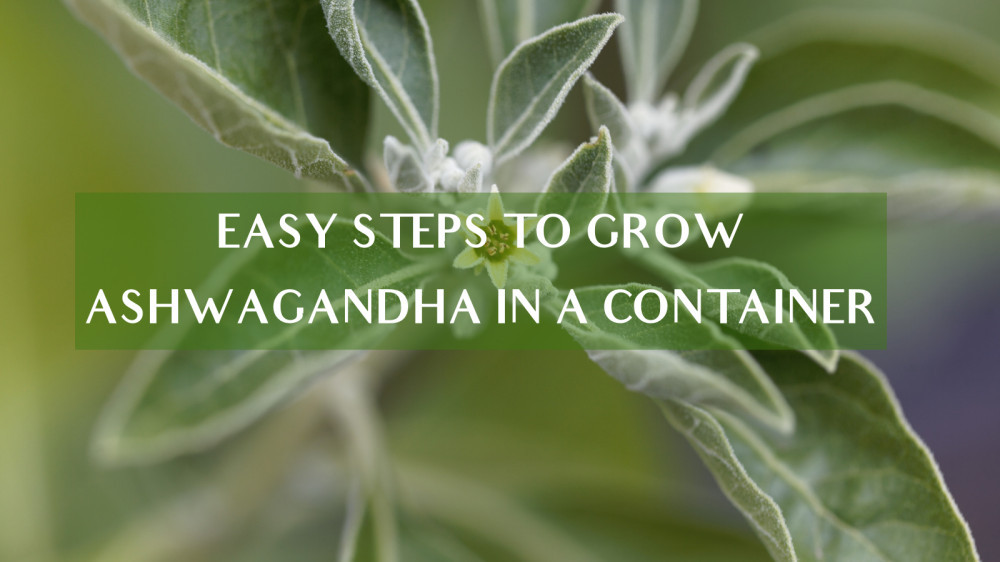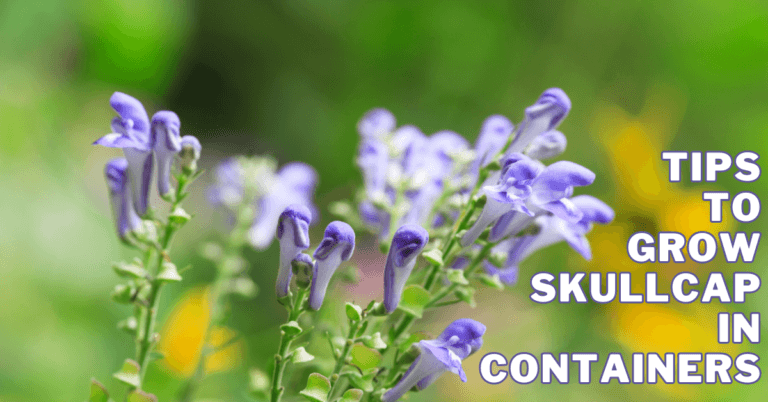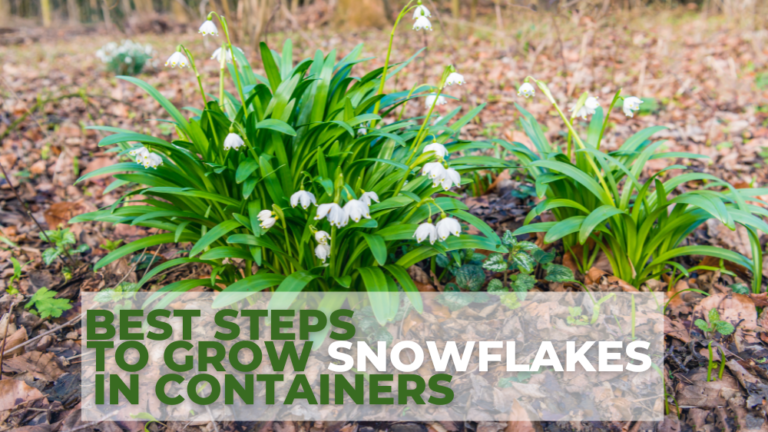Easy Steps To Grow Ashwagandha In A Container
Easy Steps To Grow Ashwagandha In a Container
Withania somnifera, also known as ashwagandha, is gaining popularity in the west and is best known for its capacity to lower stress levels and foster a calmer, happier state of being. According to a growing body of research, an astounding array of health advantages are being attributed to this potent herb. I hope these tips to grow ashwagandha in a container will be helpful for you.
History & Origin Of Ashwagandha
As a Rasayana, Withania somnifera (Ashwagandha) is a highly valued herb in the Indian Ayurvedic medical system (tonic). It is specifically utilized as a nervine tonic and is used for a variety of illness processes.
Numerous scientific research was conducted in light of these facts, and its adaptogenic and anti-stress properties were carefully examined.
Rats' endurance during swimming endurance tests is increased in experimental models, and ascorbic acid and cortisol alterations caused by swimming stress are averted.
Withania somnifera (WS) pretreatment demonstrated significant protection against stress-induced stomach ulcers.
Chinese hamster ovary (CHO) cell cancer is resistant to WS. It was likewise discovered to be efficacious in mice with lung adenoma caused by urethane.
Long-term treatment with WS for uterine fibroids and dermal sarcoma managed the condition in some patients. It has a cognition-promoting effect and was helpful for elderly adults who lost their memories and children with memory loss.
Additionally, it was discovered to help treat neurological illnesses like Parkinson's, Huntington's, and Alzeimer's disease. It has a GABA mimicking effect and has been found to encourage dendritic development. It reduces anxiety and boosts energy while also benefiting mitochondrial health.
It has been reported effective in clinical cases of osteoarthritis and rheumatoid arthritis. It is an anti-inflammatory and anti-arthritic drug. Large-scale investigations are required to demonstrate its clinical efficacy in malignancies, neurological diseases, and disorders related to stress.
Short and delicate, this species grows to a height of 35–75 cm (14–30 in). Radially branching from a central stem are tomentose branches. The leaves are oval, dull green, and often 10–12 cm (3.9–4.7 in) long. Small, green, and bell-shaped, the blooms are. Fully ripe fruit is orange-red. Many of India's arid regions are used to cultivate Withania somnifera.
Additionally, it can be found in China, Yemen, Nepal, and Sri Lanka. It enjoys sun to partial shade and dry, stony soil. It can be multiplied by planting seeds in the early spring or cuttings made from the greenwood of last spring.
Health Benefits Of Ashwagandha
The Middle East and some regions of Africa are home to the ancient and traditional medicinal herb known as ashwagandha. The word “ashwagandha,” which means “horse smell” and “horse” in Sanskrit, alludes to the herb’s aroma and the vigour it offers. People have used ashwagandha’s roots and orange-red fruit for ages for various medical uses. This herb treats our physical ailments and enhances our mental health. Below are some health advantages of ashwagandha.
1. Relieves Stress and Anxiety
The most well-known benefit of ashwagandha is its capacity to reduce stress. Ashwagandha has been shown in numerous studies to significantly lower participants' levels of stress and anxiety. One particular study also showed that ashwagandha could improve sleep quality; researchers found that participants slept significantly better with doses of the herb than with doses of a placebo.
2. Lowers Blood Sugar and Fat
Ashwagandha was proven beneficial in lowering triglycerides and blood sugar levels in a few minor clinical studies (the most common type of fat in the blood). One study compared the blood sugar-lowering properties of ashwagandha to those of drugs used to treat type 2 diabetes.
3. Increases Muscle and Strength
The effectiveness of ashwagandha in increasing muscle mass and strength is still being researched. According to one study, participants had more strength and speed. In another study, people who took ashwagandha had more muscle power, lower body fat, and lower cholesterol levels.
Some participants reported better sleep, although this study did not contrast ashwagandha use with a placebo. In another trial that only included male participants, ashwagandha treatments produced favourable outcomes.
Men who received ashwagandha experienced significant reductions in body fat percentage and post-workout muscle damage, as well as improvements in muscle strength (as assessed by bench press and leg extension activities) and size in their arms and chests compared to the placebo group.
4. Improves Sexual Function in Women
According to at least one clinical trial, ashwagandha can help women with sexual problems. According to participant self-reports, the administration of ashwagandha significantly improved arousal, lubrication, orgasm, and satisfaction. Additionally, it significantly increased the quantity of successful sexual interactions and reduced measurements of suffering related to their sexuality and sex lives.
5. Boosts Fertility And Testosterone Levels In Men
For males, ashwagandha might positively affect reproduction. By readjusting the levels of reproductive hormones, giving ashwagandha to infertile men has considerably enhanced sperm quality.
Fourteen percent of the male patients' partners were pregnant after one trial. Separately, ashwagandha was found to enhance testosterone levels in male but not female volunteers in a stress-related study, according to researchers. Another investigation into the impact of ashwagandha on male muscle strength found that testosterone levels significantly increased.
6. Sharpens Focus And Memory
Ashwagandha may enhance mental acuity, memory, and the capacity for effective motor responses following instruction. In small studies, Ashwagandha significantly reduced participants’ reaction times compared to placebo during cognitive and motor assessments (which measure the ability to respond to instructions and perform an indicated action).
According to one study, ashwagandha dramatically increased participants’ capacity for sustained attention and their short- and long-term memory across various tasks.
7. Supports Heart Health
Ashwagandha can raise VO2 max levels, which measure the highest amount of oxygen your body can absorb during physical activity, according to at least two studies. These values assess cardiorespiratory endurance or the efficiency with which the heart and lungs supply oxygen to the muscles during exercise.
Therefore, higher VO2 max levels can signify a heart in good health and functions effectively in certain conditions. The findings of this particular study might not be generalizable given that it only included healthy, active individuals as participants as opposed to a more diverse group.
Grow Ashwagandha In A Container
Although ashwagandha plants are often only found in India and Nepal, they can be grown successfully in a home garden. It is a powerful remedy in the Ayurvedic system and is also referred to as Indian ginseng.
It is said to give users the vigour and strength of a stallion, and western herbalists recognize it as an adaptogen that may be used to treat a wide range of ailments. Although the Ashwagandha herb is easy to produce and does well with little attention, it can be expensive to purchase, especially in supplement form.
Grow Ashwagandha From Seeds
- Early in the spring, sow ashwagandha seeds indoors. The plants might take up to 180 days to reach maturity, and the soil temperature must be at least 70°F for the seeds to germinate. Starting them inside is the most straightforward approach to ensure a long growing season.
- Fill many plastic pots or a seed propagation tray with organic, nutrient-rich soil that drains well.
- After planting the seeds in the pots plenty of water and a thin layer of dirt to cover them with.
- Place the seed pots on a windowsill in a warm, sunny area.
- It can take 10 to 14 days for ashwagandha seeds to sprout. Up until the seedlings emerge, ensure the soil is kept consistently moist.
- When you see seedlings, you can gradually cut down on watering but never allow the soil to dry.
- When the baby ashwagandha plants are at least 4 inches tall, you can transplant them into the garden soil.
Grow Ashwagandha From Cuttings
- You can utilize this propagation technique if you have an established Ashwagandha plant at least 12 inches tall.
- Cut a portion of the stem 4 inches long using a pair of sharp gardening shears. Remove the bottom leaves by cutting ¼ inch below the growing node. The Ashwagandha slice should be placed in a glass or jar that has been filled with water. The growth node should be submerged, but the leaves shouldn't be. To hasten the propagation process, you can also use a rooting hormone.
- Place the glass in a warm, sunny area and cover it with a transparent plastic sheet to help maintain humidity.
- Every five to seven days, replace the water in the glass.
- Be patient; it may take the cutting several weeks to develop roots. You can put your new Ashwagandha plant in the ground once the roots are at least 2 inches long.
Choose A Container To Grow Ashwagandha In A Container
Ashwagandha plant seeds can be sown indoors in tiny pots or containers that should have drainage holes, preferably clay pots. Push the seeds about one-fourth inch below the soil's surface if you're growing ashwagandha indoors. Once they grow 4 inches, you must transplant the plant into the soil outside.
Soil Requirements To Grow Ashwagandha In A Container
Fill pots with acidic or neutral pH-leveled sandy, loamy, or well-drained clay soil. For optimal results, use dry, nutrient-rich, and rocky soil. In the early spring, sow your ashwagandha seeds. Soil. Water needs sandy soil that drains effectively for it to flow out fast.
The pH level should be between 7.5 and 8, which is neutral to slightly alkaline. Ashwagandha cannot be grown on soil that continues to hold water and become saturated.
For water to flow out fast, it needs sandy soil that drains effectively for it to flow out fast. The pH level should be between 7.5 and 8, which is neutral to slightly alkaline. Ashwagandha cannot be grown on soil that continues to hold water and become saturated.
Location Requirements To Grow Ashwagandha In A Container
Ashwagandha should be planted in a garden area that is dry and sunny. If the soil is deficient, replenish it with manure and clear the planting area of weeds and debris. After the last frost, ashwagandha plants can be put outdoors in containers.
The seedlings, 35 to 40 days old, can be put in the ground or pots with sandy, well-drained soil. It is necessary to bury the seedlings between 1 and 3 cm into the soil. Although ashwagandha plants are often only found in India and Nepal, they can be grown successfully in a home garden. It is also referred to as Indian ginseng and is a powerful remedy in the Ayurvedic system.
Sunlight Requirements To Grow Ashwagandha In A Container
The sun should be shining directly on this medicinal plant. Choose a location for the plant's growth where it may receive 8 hours of sunlight. In this instance, choose a spot with abundant sunlight and plant the seeds there in the early spring or after any potential frost has passed and the soil has warmed. Ashwagandha loves soil that drains quickly, is dry and sandy, and has a pH between 7.5 and 8.
Ashwagandha bushes, indigenous to India, can reach heights of 3 feet or more and produce light green blossoms beginning in the summer that turns into orange or deep red berries by the end of the season. Ashwagandha has minimal or moderate water requirements and enjoys full sun and generally dry environments.
Temperature
Ashwagandha is tolerant of slight dryness. This plant needs a temperature range of 20 to 35 degrees Celsius to flourish indoors. After germination, which takes about 2 weeks, Ashwagandha plants need temperatures between 70 and 95 degrees to flourish at their best.
From seeds, ashwagandha is propagated. It is grown in India in low-rainfall areas at the start of the rainy season, directly after the pre-monsoon, in hot, muggy circumstances, with temperatures between 75 and 85 °F (25 and 30 °C).
Once established, it is a drought-tolerant plant that thrives in dry soil. The perennial herb ashwagandha is hardy to zone 6. My growing environment, a chilly zone 4 with a 100-day growing season, differs somewhat from the climate in India. Between 68°F and 95°F is the best temperature range for ashwagandha cultivation.
This plant does not tolerate frost. In USDA zones 7 to 12, you can grow it as a perennial, while in zones 4 to 8, you can grow it as a summer annual.
If you reside in a colder climate, start Ashwagandha seeds indoors; then, when the temperature reliably rises over 59°F, transplant the plant to your garden.
Propagation And Planting
From seeds, ashwagandha is propagated. It is grown in India in low-rainfall areas at the start of the rainy season, directly after the pre-monsoon, in hot, muggy circumstances, with temperatures between 75 and 85 °F (25 and 30 °C). Once established, it is a drought-tolerant plant that thrives in dry soil.
Plant ashwagandha seeds when the temperature is about 70 F, 2 cm deep, and 10 cm apart (20 C). In two weeks, seeds will begin to sprout. While the seedlings are established, give them plenty of water. After a month of growth, thin out the weak plants, leaving plants 50 to 60 cm apart.
Fertilizer Requirements
Like most therapeutic herbs, ashwagandha doesn't require fertilizers. India believes that applying fertilizers might change the flavour of the roots. You should also refrain from using synthetic fertilizers because they can harm human health for medical purposes.
Using a soil mixture that has been enhanced with organic matter is the most straightforward approach to guarantee that Ashwagandha obtains enough nutrients. Before you begin planting, you can increase soil fertility by adding compost or manure; this will be sufficient to ensure your plant's success.
Pests And Diseases Of Ashwagandha
Aphids and spider mites are two common pests that may affect ashwagandha plants. When the plant is young, check it frequently, and pay great attention to the newest shoots because they are more susceptible to being attacked by pests.
To get rid of aphids, use an insecticidal soap solution, and to get rid of spider mites, combine water and isopropyl alcohol. The Ashwagandha plant is most frequently afflicted by an Alternaria leaf spot. The yellowing of the leaves is one sign, followed by brown patches on the foliage.
The best fungicides to treat this kind of leaf spot include copper or sulphur. Bordeaux combination is the most excellent option if you're seeking an organic fungicide.
Harvesting Ashwagandha
It can take up to 6 months for ashwagandha to mature because of its slow development rate. It is time to harvest when the papery husk that protects the berries starts to dry up. In India, Ashwagandha is harvested with specific equipment. However, you can quickly harvest this plant by hand in your backyard.
Give the dirt a good soak before grabbing the plant from the base of the stem and pulling it out to make harvesting simpler. To loosen the soil, you can also use a trowel, but take care not to harm the roots.
Use a sharp blade to cut through the Ashwagandha's roots and stem, then wash the plant to remove the soil. Cut each root into smaller, 2 to 3-inch long parts after trimming the roots from the root ball. Set up a drying rack and equally distribute the roots throughout the surface. Until the roots are dehydrated, keep the rack in a dry, shaded, and well-ventilated area.
Conclusion
Although the Ashwagandha herb is easy to produce and does well with little attention, it can be expensive to purchase, especially in supplement form. If you want to ashwagandha in a container hope my suggested tips will be helpful for you.
I trust you enjoyed this article on the Easy Steps To Grow Ashwagandha In A Container. Please stay tuned for more blog posts to come shortly. Take care!
JeannetteZ
>>>Please click here to read my all-inclusive article about Container Gardening<<<
>>>Are you interested in homegrown herbs and medicine? Please click here to find out more about it!<<<
Your Opinion Is Important To Me
Thoughts? Ideas? Questions? I would love to hear from you. Please leave me your questions, experience, and remarks about this article on the Easy Steps To Grow Ashwagandha In A Container, in the comments section below. You can also reach me by email at Jeannette@Close-To-Nature.org.
Disclosure
This post may contain affiliate links. As an Amazon Associate and other affiliate programs, I earn from qualifying purchases at no extra cost to you. Read my full affiliate disclosure.
You might also enjoy these blog posts:
Easy Steps To Grow Ginger In A Container
Must-Have Products For Dog Owners
20 Essential Cleaning Tips For Every Pet Owner



















